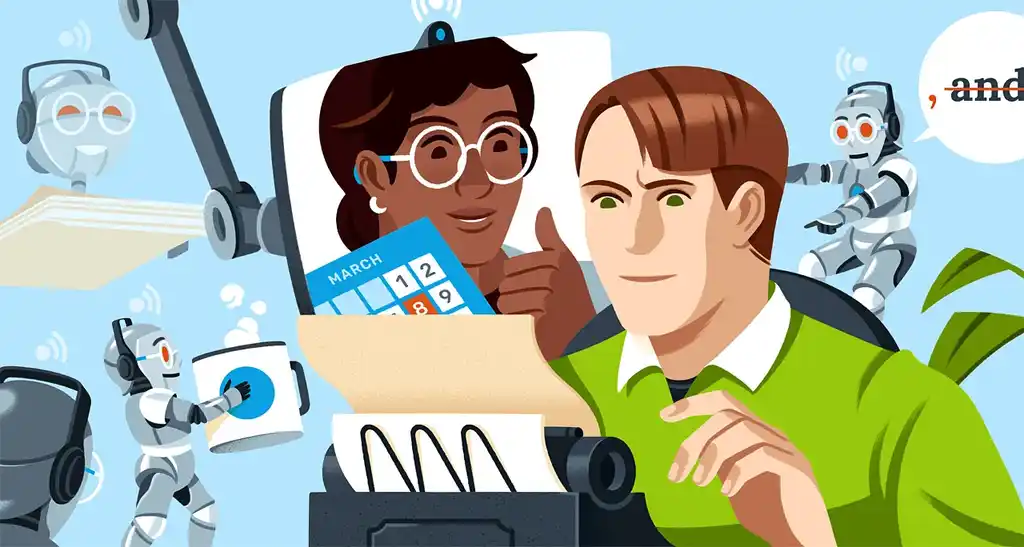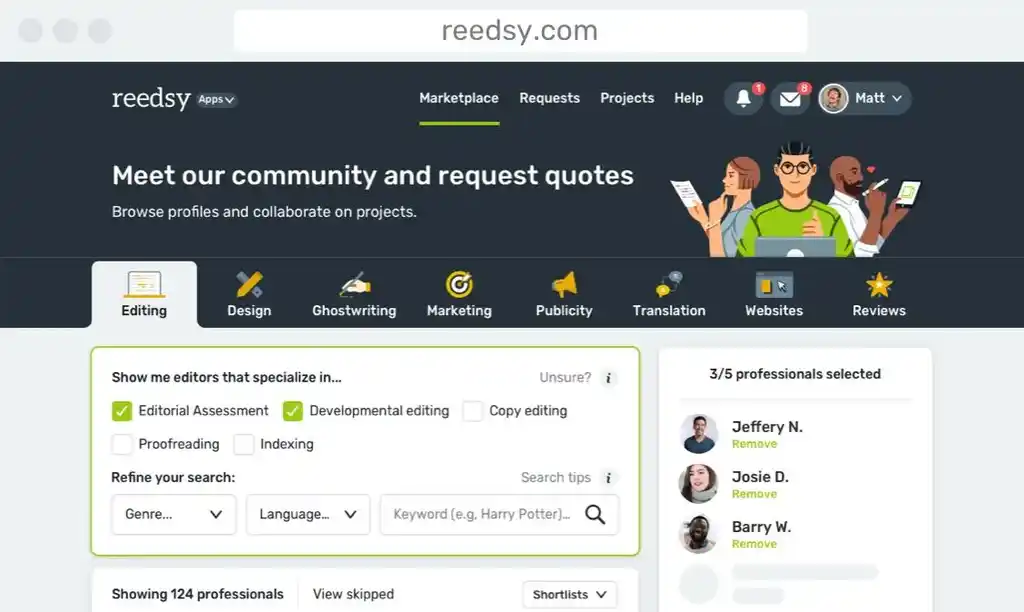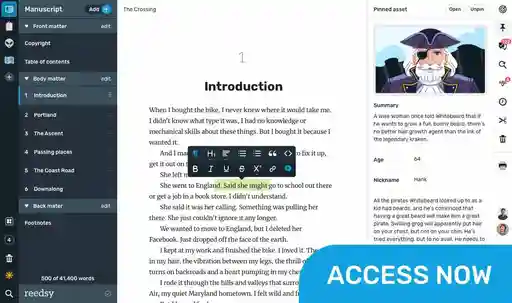Guides • Perfecting your Craft
Last updated on Oct 14, 2025
Third Person Limited: the Definitive Guide + Examples
Dario Villirilli
Editor-in-Chief of the Reedsy blog, Dario is a graduate of Mälardalen University. As a freelance writer, he has written for many esteemed outlets aimed at writers. A traveler at heart, he can be found roaming the world and working from his laptop.
View profile →Welcome to our guide on arguably the most popular point of view of all: third person limited. Combining the strengths of third person omniscient and first person, third person limited accounts for many of the books you’ll see on bookshelves today. But what is it about this POV that makes it so popular?
In this part of our guide to literary points of view, we’ll break down what it means to write from a limited perspective, examining the benefits and potential pitfalls.
What is third person limited point of view?
Third person limited is a point of view in which the narrator tells the story from one character’s perspective at a time, using the pronouns he, she, and they to describe their thoughts and actions. Here’s an example:
He knew it would be over the moment that he approached her.
How is third person limited different from other point of views?
Third person limited is just one type of third person point of view. The other is third person omniscient.
However, they couldn’t be more different from each other. While third person omniscient features an all-knowing narrator, third person limited is restricted to just one character’s perspective at a time. In this respect, third person limited is similar to first person point of view.
Q: What are the most common craft mistakes new authors make?
Suggested answer
One of the biggest mistakes I see from new authors is that they finish writing their manuscript and then they think they are done and ready for an editor to go through and review.
Writers need to be their own editors first. Because there are so many potential new authors every day, it's imperative that writers go back and edit their work thoroughly. That means reading, and rereading what they've written to understand how their characters develop through their novel, or how the topics that they brought up in chapter two are refined and built upon in chapter nine. Through that reading process, writers should be editing their work as they find pieces that aren't strong enough or need to be altered to make a better overall manuscript.
Matt is available to hire on Reedsy ⏺
The most common writing mistake I see from first-time authors is cramming too much into the first chapter. Your first chapter is a meet and greet, where you establish credibility, likability, and optimism that the book is worth the reader's time. Hook the reader, show your personality, but don't dump all your knowledge on them at the beginning of the book. Take them on an interesting, helpful journey,
Mike is available to hire on Reedsy ⏺
Ursula Le Guin once provided a succinct definition of this limited viewpoint: “Only what the viewpoint character knows, feels, perceives, thinks, guesses, hopes, remembers, etc., can be told. The reader can infer what other people feel and think only from what the viewpoint character observes of their behavior.”
But it differs from first person POV (and second person POV) in that you don’t always need to be tuned into every thought inside of the main character’s mind. Instead, you have the option of taking a step back. Like Brandon Sanderson, author of Mistborn, also explained in a lecture about viewpoints: “With a first person narrator, you’re always getting the sense of, “Me! Me! Me!” Pay attention to me, as opposed to the actual scene. You can do the latter better in third person limited.”
What are the advantages of third person limited point of view?
The ability to zoom out and portray characters through a ‘cinematic lens,’ as we discussed, contributes to the lasting popularity of this POV, but there are even more perks to it than that.
Let’s break it down now — along with a cautionary note about its one prevailing disadvantage.
Third person limited has access to a character’s thoughts
Third person limited offers access to a character’s inner thoughts and emotions, much in the same way that first-person narration does. As a result, it creates a strong sense of narrative empathy, making it easier for readers to imagine themselves in the viewpoint character’s shoes — or as their confidante.
When handled well, you could argue that third person limited is even more intimate than a first person narrative. Instead of a protagonist telling you their story, you are indirectly encouraged to experience the story as the protagonist does. A powerful trick of the trade!
Third person limited narrators are often more reliable than first person narrators
Though it certainly creates empathy and intimacy between the reader and the viewpoint character, the third person limited perspective benefits from slightly greater objectivity than first person. First person narrators can have biases, limited self-awareness, or a reluctance to share crucial facts 一 making them unreliable at times. An external narrator, instead, can describe things more accurately, adding important meaning and context to a character’s behavior (and transformation).

GET ACCOUNTABILITY
Meet writing coaches on Reedsy
Industry insiders can help you hone your craft, finish your draft, and get published.
It maintains a level of uncertainty and surprise
In the mystery, suspense, and thriller genres, you’ll commonly see third person limited narration. Compared to other POVs, it’s a more natural way to tell a story that has a lot of unknowns — things like revelations and plot twists.
An omniscient narrator, by their very nature, knows who the killer is in a mystery, but must carefully omit details to keep the mystery alive. A limited third person narrator, on the other hand, only reveals what the viewpoint character knows, allowing the reader to uncover the mystery only as it occurs to the protagonist. If the focal character is surprised by a plot twist, the reader will be as well.
But using third person limited requires discipline and focus
The most common pitfall with the third person limited POV is “head-hopping,” which is when the narrator reveals the thoughts or feelings of a non-focal character. In other words, they “hop” from head to head among multiple characters, rather than sticking close to their focal character.
Q: Why is head-hopping considered a problem in fiction?
Suggested answer
When there is head-hopping in a story, it detracts from the main character and makes the story too muddy. The reader won't know who the lead is in the story and who they should be rooting for. It also goes against traditional publishing norms of one point of view or multiple points of view with a different character viewpoint per chapter, with no more than 4 points of view in total for one book.
There are other ways for readers to know what a secondary character is thinking.
- That character can speak, so dialogue is used to convey their feelings.
- Physical expressions like clenched fists, smiles, etc., can communicate things to readers and other characters.
Melody is available to hire on Reedsy ⏺
For example, imagine a scene in which your POV character, Ciara, is speaking to a priest:
Ciara felt her heart pounding as she finally mustered up the courage to ask the big question. “Were you there when my sister died?” Father Walsh paused. Not wishing to upset the poor girl, he quickly concocted a version of the truth that Ciara could handle.
This would be a misuse of the third person limited, as there’s no way for Ciara to know what Father Walsh is feeling — unless she is a mind reader, in which case all bets are off. You can, however, demonstrate Father Walsh’s reluctance by employing some classic “show, don’t tell” action. Your POV character can observe him avoiding eye contact, stopping and starting sentences, or fidgeting with his cuffs — all evasive gestures that suggest reluctance or deceit.
Head-hopping is already not ideal when it happens with omniscient narrators, but it’s positively disastrous with a limited POV. While modern editing programs will detect when you're shifting between passive and active tense, they won't be able to warn you when you've accidentally swapped your point of view character. In this case, the professional eye of an editor can surely help to revise your manuscript and keep your perspective consistent.

What do Neil Gaiman, Isabel Allende and Joyce Carol Oates have in common?
They've all worked with Reedsy editors. Sign up today and work with them on your next book.
Learn how Reedsy can help you craft a beautiful book.
Examples of third person limited point of view in action
Now that you know what to watch out for, let’s look at how authors have wielded third person limited POV in the past.
1. Ender’s Game by Orson Scott Card
But Ender knew, even as he thought it, that Peter wouldn’t leave him alone. There was something in Peter’s eyes, when he was in his mad mood, and whenever Ender saw that look, that glint, he knew that the one thing Peter would not do was leave him alone. I’m practicing piano, Ender. Come turn the pages for me. Oh, is the monitor boy too busy to help his brother? Is he too smart? Got to go kill some buggers, astronaut?
Through the third person limited perspective, Orson Scott Card gives a peek into our protagonist’s thoughts. From his deductions of another person’s behavior (“But Ender knew [...] that Peter wouldn't leave him alone”) to Ender’s imagined harassment by Peter, we’re right there in our protagonist’s head.
2. A Confederacy of Dunces by John Kennedy Toole
A green hunting cap squeezed the top of the fleshy balloon of a head. The green earflaps, full of large ears and uncut hair and the fine bristles that grew in the ears themselves, stuck out on either side like turn signals indicating two directions at once. Full, pursed lips protruded beneath the bushy black moustache and, at their corners, sank into little folds filled with disapproval and potato chip crumbs.
In the shadow under the green visor of the cap Ignatius J. Reilly’s supercilious blue and yellow eyes looked down upon the other people waiting under the clock at the D.H. Holmes department store, studying the crowd of people for signs of bad taste in dress. Several of the outfits, Ignatius noticed, were new enough and expensive enough to be properly considered offenses against taste and decency. Possession of anything new or expensive only reflected a person’s lack of theology and geometry; it could even cast doubts upon one’s soul.
In A Confederacy of Dunces by John Kennedy Toole, the narrator puts us in the head of his buffoonish protagonist — showing us what he’s thinking while also reminding us to take it all with a grain of salt. Indeed, only a third person could inform the reader that, while Ignatius judges other people’s fashion as an ‘offense against taste’, he himself looks preposterous.
Q: What makes a compelling first chapter in a novel?
Suggested answer
The first chapter of any novel is so, so important. It's where the story is set up so that readers can get a taste of what they're in for over the next 8-12 hours. However, there is a multitude of elements that go into successful first chapters, and they must be expertly woven together to make it compelling. By the end of the first chapter, it comes down to one thing: if the reader isn't hooked, they likely won't continue. And they need three things to keep them interested.
- Curiosity
- Tension
- Emotion
The sooner these things become apparent in the pages, the better. Readers want to feel emotionally connected to the main character so that they can empathize with them, feel like they intimately know them, and root for them to reach their goal. They want to care about what happens to them. If there's tension, readers will worry about them and be curious about how it's going to play out. And when readers are curious, that means they're theorizing about what might happen. If they're theorizing, they're engaged in the story. Their brains feel like they're actively participating in figuring things out--and that's what makes them feel compelled to keep turning those pages.
My favourite novels aren't the ones that open with a beautiful sunrise or a description of the surroundings or backstory or having a character wake up. These are cliché in today's publishing landscape. Instead, they have opening lines or paragraphs that evoke such strong curiosity in me, something shocking or surprising or unexpected, that I'm hooked right from the start. These are the novels that hold my attention not just through the first chapter, but through all of them. The authors make sure there's curiosity, tension, and emotion present, along with other elements, such as a hint about the protagonist's internal conflict and flaws, an idea about goals and stakes, their desires, an imbalance of power, more showing than telling, etc. that contribute to my brain's need to feel engaged and interested.
So, it's not just about having all the elements that go into writing an exceptional novel. It's the art of weaving them all together in a style and voice that's intriguing and engaging from the very first page. Readers of fiction want to be entertained, so it's your job as the writer to make that promise and follow through with it by capturing their attention as soon as possible in the first chapter and not letting go until the very last page.
Kathleen is available to hire on Reedsy ⏺
Starting with a strong opening line that is intriguing will help pull the reader into the narrative.
"Where is Papa going with that axe?" is the opening line of Charlotte's Web. We open with intrigue, and in the middle of the action of the story.
Then you want to have a strong build-up to the inciting incident, which should come at about 12,00-13,000 words into the story.
You want your main character to be likable and interesting to the reader.
You want to leave any backstory details for later on and keep the action of your opening scene continuous and going strong.
Then, if possible, you want to end this chapter with the promise of more "trouble" to come or an unanswered question regarding the trouble at hand, or at the very least, some ruffled feathers regarding your main character. There needs to be trouble brewing soon, and discomfort felt by your hero.
Melody is available to hire on Reedsy ⏺
Through the added context, we quickly discover the contradictory nature of the character, something he wouldn't have told us if we were getting the story directly from him.

3. Murder on the Orient Express by Agatha Christie
“Ah! my good friend,” cried M. Bouc. “Come in. We have need of you.”
The little man in the window shifted along the seat, and Poirot squeezed past the other two men and sat down facing his friend.
The expression on M. Bouc’s face gave him, as he would have expressed it, furiously to think. It was clear that something out of the common had happened.
“What has occurred?” he asked.
“You may well ask that. First this snow-this stoppage. And now—”
He paused—and a sort of strangled gasp came from the Wagon Lit conductor.
“And now what?”
“And now a passenger lies dead in his berth—stabbed.”
In Agatha Christie’s classic Murder on the Orient Express, Detective Hercules Poirot is on a train on his way back to London, when he is informed about… the titular murder. It’s the inciting incident that sets Poirot on a “journey” to find out who’s the culprit. By having an up-close yet limited access to his viewpoint, the reader will be able 一 as the story unfolds 一 to feel his confusion, frustration, and excitement in trying to solve the case.

4. A Storm of Swords by George R.R. Martin
‘‘Mercy!’’ Catelyn cried, but horns and drums and the clash of steel smothered her plea. Ser Ryman buried the head of his axe in Dacey’s stomach. By then men were pouring in the other doors as well, mailed men in shaggy fur cloaks with steel in their hands. Northmen! She took them for rescue for half a heartbeat, till one of them struck the Smalljon’s head off with two huge blows of his axe. Hope blew out like a candle in a storm.
We spoke earlier about how writers who use third person limited can control “camera angles.” Here’s an example from A Storm of Swords of the narrator zooming slightly out to show the entire (unfortunate) scene of the Red Wedding. Note the moments when we’re inside Catelyn Stark’s head, and when we’re simply seeing what’s happening.
Q: What daily writing routines can help authors maintain consistent productivity?
Suggested answer
+ Never underestimate the power of enough sleep. This can cure more things than we know - how we show up, what we're capable of tackling each day.
+ Nourishing food to fuel the mind.
+ Movement - even if it's a walk around the block listening to a podcast, music or just deep in thought (often the best times when ideas arise).
After these three things are locked in:
+ Quiet, undistracted time blocks (even if it means phone in another room for 90 mins)
+ A laptop that has nothing else except Word on it (no website access).
+ For those who are visual, keeping a yellow sticky note daily "checklist" on a wall, to encourage a daily writing tally.
+ Ask for feedback for continual improvement.
Leoni is available to hire on Reedsy ⏺
There are four things that I consider before settling in to write.
What sounds are there? The best is silence, but in a city environment this is impossible. If there are specific loud that I want to block out, I listen to drone music. This consists mostly of long, sustained notes (no melodies) and comes from the American and German post-war experimental musical traditions. The texture of the sounds is often rich which works for this purpose quite well. It has a meditative effect. Failing this, music without lyrics is also good.
What is my phone doing? Just switch it off.
Social media. Along with my phone, this is designed to distract. What I do is log out of my social media accounts. If I automatically go back in, I'm then met by the login page. This doesn't sound like much of a difference, but is just enough to nudge myself into becoming mindful of what I'm doing and what my present purpose it. And mindfulness is key.
Lastly, I take a page of Hemingway's advice: "The first draft of anything is s**t." It's ok to produce bad writing. In fact, it's totally ok; actually it's great. Why? Because my ideas are now down on the page, even if it's absolutely horrible. Nobody ever simply writes a finished product straight off the bat. I'll make it better later and that is a different process.
Don is available to hire on Reedsy ⏺
Get all domestic and admin chores out the way first, so that there is nothing else on your mind when you sit down to write. Then just stick at it for as long as possible.
Andrew is available to hire on Reedsy ⏺
5. The Giver by Lois Lowry
It was almost December, and Jonas was beginning to be frightened. No. Wrong word, Jonas thought. Frightened meant that deep, sickening feeling of something terrible about to happen. Frightened was the way he had felt a year ago when an unidentified aircraft had overflown the community twice. He had seen it both times. Squinting toward the sky, he had seen the sleek jet, almost a blur at its high speed, go past, and a second later heard the blast of sound that followed. Then one more time, a moment later, from the opposite direction, the same plane.
And on the flip side of things, writers can also zoom in to focus on the main character up close. Here in Lois Lowry’s The Giver, we’re drawn into Jonas’ mind with the simple addition of the phrase, “Jonas thought.” From that point on, we’re privy to Jonas’ thoughts, feelings, and emotions in the moment described.
When should you use third person limited point of view?
As always: the answer depends on the story you’re telling, and on your own preferences for writing point of view. Before you commit to using third person limited point of view, ask yourself these key questions:
- How much distance do you want from your character? Does your story require you to be up close and personal to the main character all the time? If so, then you may want to consider first person POV. Rather have the option of stepping back at times? Then third person POV would be more natural for you to use.
- How big is your cast of characters? If you have a large cast of characters, and you’d like to get into each of their heads without relying on an omniscient narrator, then you may want to consider using multiple third person POVs (which we discuss in the final part of this guide). First person multiple POVs can quickly get confusing for readers.
- Are you a chronic ‘head-hopper’? Any instance of “head-hopping,” as we discussed, is often an automatic no for literary agents — so you’ll need to be extra careful if you decide to go with the third person limited POV. Should you use it, we strongly recommend that you get a beta read or a professional copy edit to ensure that you didn’t head-hop at any point in your story.
The third person limited is a favorite POV of authors and readers alike, but fiction has a place for its omniscient counterpart too. If you're ready for a 'wider' viewpoint, head on to our next post on third person omniscient.

